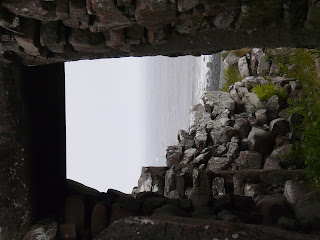On Thursday 21st June, a cold wet June Thursday, my daughter Therese graduated from Glasgow University with an honours degree in Chemistry. Damien, James, Mum and I were present in the vast hall with hundreds of other families and friends to witness the capping ceremony in the precint of this ancient University.
I was very proud. We all were very proud. Therese has worked hard and has overcome many stumbling blocks on the way to her degree. She earned her qualification.
(Worth stating here I am very proud of all my children. Martin, Damien, John, James, Gerry and Therese. They are all working hard, and working in professions they wanted to be a part of. Acting, writing, music, science.)
Therese's next obstacle to be overcome is finding a suitable job. She has sent off numerous applications, but so far no offers even of interview. Such is the world today for young people.
Before the ceremony began at 11am, we attended Mass at Turnbull Hall, the University's catholic Chaplaincy. Fr Keenan said the mass. There was a welcome cup of coffee after the Mass before we made our way back to the Main Building.
The Graduation Ceremony was one with pomp and formality. We sang a hymn as the Professors processed into the Hall. We sang in Latin!
The principal in his speech mentioned the history of the University, the Reformation and the Enlightenment. He did not refer to its Catholic roots, though he did mention John Henry, Cardinal Newman.
It was an amazing sight to see the rows of new Graduates in their Academic gowns and hoods, a rainbow of colour. To observe the traditional ceremony of capping and hooding.
And afterwards, in the draughty quadrangle, just out of the rain, the greetings, the hugs, the photographs and the smiles and cheers. A day to cherish.
Afterwards, there was a reception in the Chemistry building, then we treked across to the Western Infirmary, where granny saw Therese in her academic gown. More photos and congratulations from folk in the ward.
Then home for a couple of hours rest. We had been up since 6 30am. It was now 4 pm.
In the evening, we drove to Tony Macaroni's Italian restaurant in Byres Road in the West end of Glasgow. There we were joined by Gerry, John and John's girlfriend Jordanna. We had a lovely meal, with some wine. We will not mention the sweets.....no we won't.....no...my lips are sealed...but check the photos.....ahem....
 |
| Getting ready for the ceremony |
 |
| A Prayer at the beginning |
 |
| Therese receives her hood |
 |
| A Rainbow of Colour |
 |
| Capping...the cap is ancient |
 |
| Nearing the close |
 |
| We did it!! |
 |
| Toasting Success |
 |
| Damien holds the parchment |
 |
| I didn't get one...... |
 |
| Therese and Lucy |
 |
| Emma and Therese |
 |
| No...not wands... |
 |
| Hogwart's Graduates |
 |
| Therese and Bob |
 |
| The Four Caballeros |
 |
| James, Dad, These, Mum Damien |
 |
| Dekusions of Intelligence.. |
 |
| Fangs a Lot! |
 |
| With Granny in Hospital |
 |
| At Tony Macaroni's..Ribs were delicious! |
 |
| Gerry and John |
 |
| Not mentioning the sweets... |
 |
| Jordana and Therese |
 |
| Jordana, John and Therese |























































